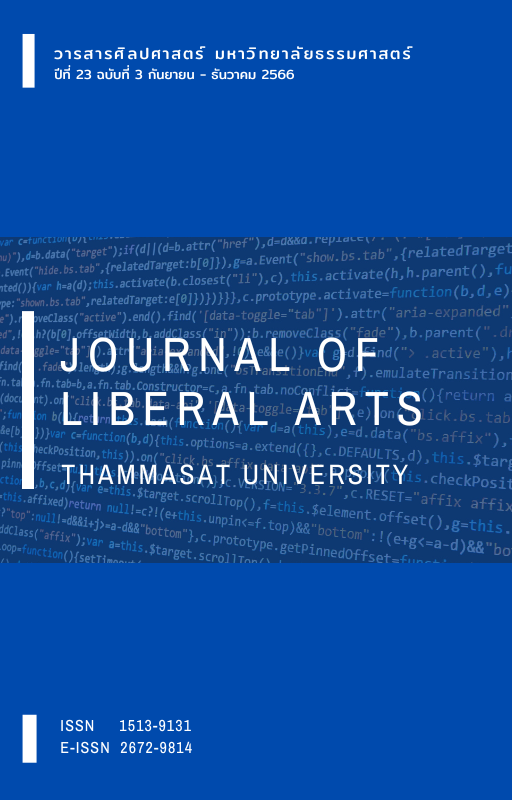The Use of Personification and Values Presented in Russian Advertising Messages
Main Article Content
Abstract
This paper aims to study the use of personification and values presented in Russian advertising messages, following the conceptual framework of Arnold (2002) regarding personification and critical discourse analysis (CDA) by Fairclough (1995). The approach analyzes the values presented in advertising messages of selected samples from the official website of the brand, using Google and Yandex as tools for data collection. The study results show that the use of personification in advertisements can be divided into 4 groups according to the types of words, which are verb usage, pronoun usage, noun usage, and adverb usage. The values presented in the advertising messages can be divided into 5 values, which are values related to tea and tea consumption, values of collectivism, values related to women, values related to colors, and values of using foreign language words. The findings are useful for teaching and learning intercultural communication and for stylistic analysis.
Downloads
Article Details

This work is licensed under a Creative Commons Attribution-NonCommercial-NoDerivatives 4.0 International License.
References
กัลป์ยกร วรกุลลัฎฐานีย์ และ พรทิพย์ สัมปัตตะวนิช. (2551). การโฆษณาเบื้องต้น. สำนักพิมพ์มหาวิทยาลัยธรรมศาสตร์.
ณัฐพร พานโพธิ์ทอง. (2556). วาทกรรมวิเคราะห์เชิงวิพากษ์ตามแนวภาษาศาสตร์: แนวคิดและการนำมาศึกษาวาทกรรมในภาษาไทย (พิมพ์ครั้งที่ 2). จุฬาลงกรณ์มหาวิทยาลัย, คณะอักษรศาสตร์, ภาควิชาภาษาไทย.
ทิพย์สุภา ตั้งวงเจริญลา. (2553). สาเหตุและแรงกระตุ้นของพฤติกรรมจงรักภักดีมากกว่า 1 แบรนด์ขึ้นไป [วิทยานิพนธ์ปริญญามหาบัณทิต]. มหาวิทยาลัยธรรมศาสตร์.
ธนวัตร มัททวี. (2559). การวิเคราะห์วาทกรรมเชิงวิพากษ์ในรายการคืนความสุขให้คนในชาติ. [วิทยานิพนธ์ปริญญามหาบัณทิต]. มหาวิทยาลัยธรรมศาสตร์.
ปรีดี นุกุลสมปรารถนา. (9 มีนาคม 2563). สร้างแบรนด์ให้โดดเด่นด้วย Brand Personality. Popticles.com. https://www.popticles.com/branding/brand-personality/
วรพงศ์ ไชยฤกษ์. (2556). วาทกรรมวิเคราะห์เชิงวิพากษ์: มุมมองใหม่ในการวิจัยทางภาษาไทย. วารสารอินทนิลทักษิณสาร, 8(1), 135-162.
Arnold, I.V. (2002). Stilistika. Sovremennyy angliyskiy yazyk. Flinta.
Askent. (2021, November 10). Aksessuary. https://vsliga.ru/shop/aksessuary/askent
Avis, M. (2012). Brand personality factor based models: A critical review. Australasian Marketing Journal, 20(1), 89-96. http://doi.org/10.1016/j.ausmj.2011.08.003.
Bmg. (2021, October 20). A kampani. https://wonderlab.eco/about
Bolkvadze B. I. (1995). Alitsetvareniye kak fenomen rechevova khudozhestvennava myshleniya. Varonezhskiy gos.uni-t.
Brend Alya. (2021, November 7). O'Stin istoriya brenda rodom iz Rossii. https://znaktm.ru/ostin-istoriya-brenda-rodom-iz-rossii.html
Calipso. (2021, September 17). Company kalipso. https://manufacturers.ru/company/kalips
Cherny Zhemchug. (2021, September 17). Apisaniye. https://irmag.ru/cat/i320553/
Country Textile. (2022, October 29). A kampani. https://countrytextile.co/about/
Dobrynina, E. (2013 July, 03). Rassiyane rasskazali satsialogam ab asobennastyakh russkava kharaktera.Rossiyskaya Gazeta. https://rg.ru/2013/07/03/osobennosti-site.html
Dzahmysheva, V. D. (2016). Yazykovye sredstva sozdaniya ekspressivnosti v sovremennoi reklame [Unpublished doctoral dissertation]. Belgorod State University.
Fairclough, N. (1995). Critical discourse analysis. Longman.
Grigorieva, O.N. (2000). Stilistika russkava yazyka. NVI.
Hansa. (2022, September 17). A Hansa. https://www.hansa.ru/company/
Hilltop. (2021, August 12). A padarachnam chae. http://hilltop.ru/index/o-podarochnom-chae
Incanto. (2021, November 7). Asobennasti brenda. https://julia-dol.ru/incantoitaly
Jalilifar, A. (2010). The rhetoric of Persian and English advertisements. The International Journal of Language Society and Culture. http://www.aaref.com.au/en/publications/journal/welcome/
John Jeniford. (2021, November 20). A brende. https://www.johnjeniford.ru/ru/page/brand
King, S. (1970). What is a brand. J. Walter Thompson.
Kupina N. A., & Matveeva T. V. (2019). Stilistika sovremennava russkaga yazyka: Uchebnik dlya akademicheskogo bakalavriata. Yurayt Publishing House.
Lotnikova, V. S. (2019). Stilisticheskiy priyem olitsetvoreniya [Unpublished Master’s thesis]. Kubanskiy gosudarstvennyy universitet.
Mai. (2021, August 12). A brende. https://maisky.ru/about/
Maitre. (2021, September 17). https://vos.by/katalog/proizvoditeli/maitre
Matromi. (2021, December 10). Nasha filasafiya. https://matromi.com/about
Monochrome. (2021, August 12). A kampani. https://monochrome.ru/en/company
Pyeoptics. (2022, September 17). A kampani. https://pyeoptics.com/pages/about
Siammsiamm. (2022, November 20). https://siammstore.com/
Spunky studio. (2021, August 12). A nas. https://spunky.ru/o-nas
Sven. (2022 September, 17). A nas. https://www.sven.fi/ru/about/
Tom, G., & Eves, A. (1999). The use of rhetorical devices in advertising. Journal of Advertising Research, 39(4), 39-43.
Rutter, R., Chalvatzis, K. J., Roper, S., & Lettice, F. (2018). Branding instead of product innovation: A study on the brand personalities of the UK’s electricity market. European management review, 15(2), 255-272.
Unipack. (2021, September 7). Infarmatsiya a kampani. https://company.unipack.ru/18464/
Zolla. (2021, August 12). A brende. https://zolla.com/about/

